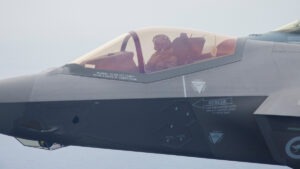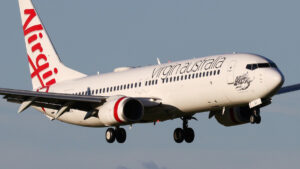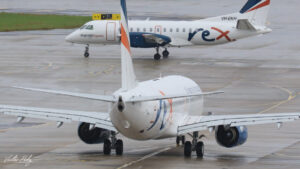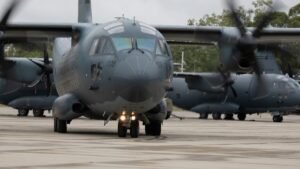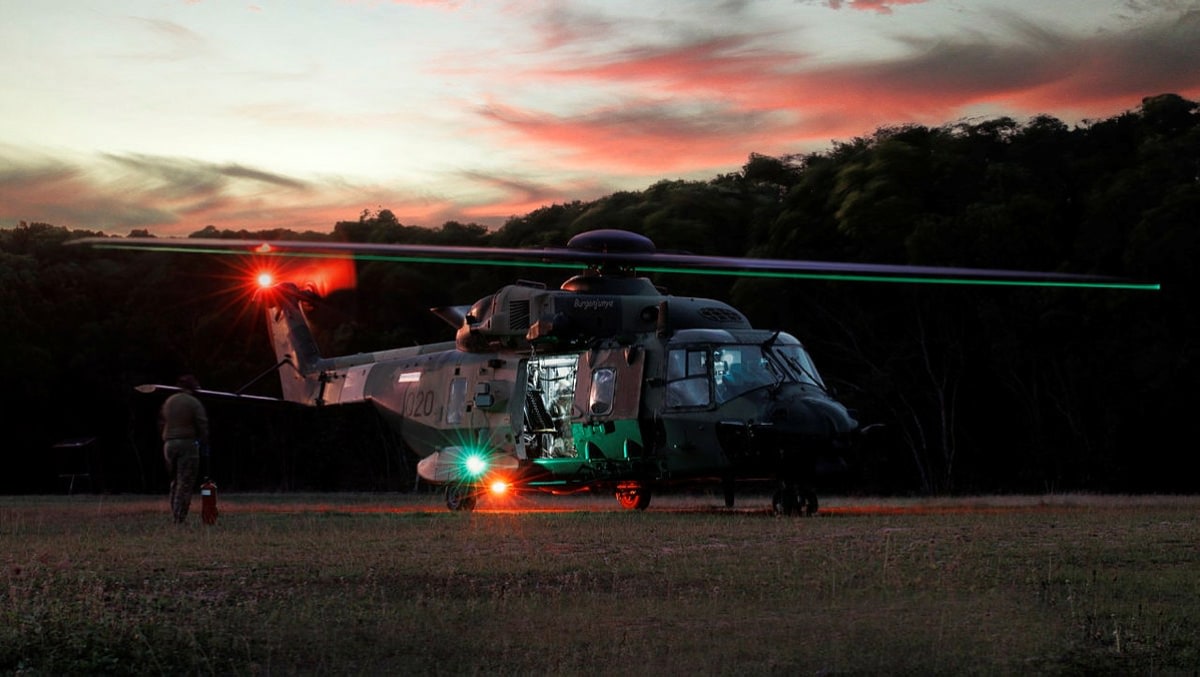
Concerns have been raised about low-altitude, low-visibility equipment utilised by the Australian Defence Force’s now-scrapped MRH-90 Taipan helicopter fleet.
Several alleged technical issues involving the MRH-90 Taipan helicopters were inquired about during a Senate committee meeting in Canberra on 25 October 2023.
In September last year, the Australian government announced that the ADF MRH-90 Taipan helicopter fleet was grounded and would not return to flying operations before their planned withdrawal date in December, following a series of aircraft accidents.
An MRH-90 helicopter crashed south of Hamilton Island while participating in Exercise Talisman Sabre in July 2023, while another aircraft ditched into NSW waters during a routine counterterrorism training exercise in March 2023.
It’s understood disassembly of the aircraft commenced in October last year.
During the Senate meeting, Australian Greens senator David Shoebridge needled Chief of Army Lieutenant General Simon Stuart regarding safety and equipment reports that the Australian Army had received about the aircraft, in particular its performance at low altitude and low visibility flight.
“Army Aviation had been in receipt of a series of reports identifying systemic problems with the helmet-mounted sight display, the TopOwl image intensifier and the forward-looking infrared system for the Taipan helicopters – a series of concerns raised in reports from 2020 onwards. That’s right, isn’t it?” Senator Shoebridge asked.
“(You received) a formal report, from the Army Aviation Test and Evaluation Section that says the helmet-mounted sight display for the Taipan helicopter was a substantial risk of multiple deaths due to controlled flight into terrain and that the display of ambiguous aircraft altitude in the helmet-mounted sight display was an unacceptable risk to flight safety.
“They (Army Aviation Test and Evaluation Section) found that the heads-up display (HMSD) … did not meet airworthiness standards. Indeed, they found that the symbology tested was observed to be incongruous with the primary flight display, creating mixed messages to and confusions for pilots, in direct breach of Federal Aviation Administration requirements. They found that, didn’t they?”
“Obviously, the risk of collision with terrain with a heads-up display is greatest when aircraft are flying low, with poor illumination, without a visual horizon. They were the circumstances in which the initial test found this was most dangerous (if you’re relying on the heads-up display).”
A 6 July 2020 report found that there was insufficient evidence to substantiate that the MRH-90 forward-looking infrared system was safe for use as a primary means of detecting and avoiding obstacles during terrain flight, he said. In addition, an AATS flight test report in July 2021 recommended that the system should only be used by the non-flying pilot because of the risks identified.
Senator Shoebridge also questioned why a subsequent review, conducted by the Army to address the identified risk of controlled flight into terrain, had excluded operating below 500 feet without a visual horizon, with less than two MLX illumination and while using the forward-looking infrared.
“Because of the risks identified in that first report, those who conducted the test were not willing to put their lives at risk by operating in those circumstances where the heads-up display was critical,” he said.
“It wasn’t just the heads-up display, was it? There were significant safety issues raised with the forward-looking infrared system, and it was found to raise such concerns that its operation by the pilot may result in ‘a catastrophic outcome’ and the error was defined as ‘probable’ and the resultant residual risk as ‘very high’ for the FLIR system. You were in receipt of that report as recently as July of 2020, weren’t you?”
Chief of Army LTGEN Stuart confirmed that all three issues had been raised and Defence was aware of the technical problems.
“You’re correct in that there were three issues that were raised. First … is the HMSD (helmet mounted sight display). The second was the image intensifier with the night vision. The third was the forward-looking infrared,” he said during the Senate meeting.
“We’re specifically aware of that particular matter (of the HMSD). It was taken seriously and acted upon through an operational evaluation, which was then assured by the Defence Flight Safety Bureau and Comcare.
“We take very seriously any indications of matters that impact on the safety of our operations, with a particular view to the safety of our people. Through things like airworthiness boards, there is the opportunity – and, indeed, we seek – for any concerns to be raised in those areas.
“That test and evaluation concern was taken seriously – as I said – was acknowledged, subject to an operational evaluation, and was acted upon.
“Advice from that part of the system is but one part of a full range of measures that, as part of the Defence aviation safety framework, are taken into consideration to ensure the air worthiness and, ultimately, the safety of our flying operations.
“There was an issue with the symbology that led to an upgrade from its original configuration. The brief history of that, of course, is that that test and evaluation advice was accepted. It led to a further evaluation for both Army and Navy aviation. It was tested against those standards and has led to an improvement and development of that HMSD.
“Each of those concerns and the articulation of risk and consequence were then properly considered in the context of the Defence aviation safety framework, and changes were made. Those changes were to the satisfaction of the regulator, and we’re talking about things that occurred between, I think, 2018 and 2020.”
“The test and evaluation organisation characterises and provides advice on risk and consequence if it’s untreated. That advice goes in to a broader Defence Aviation Safety Framework, which … in this case was subject to a full operational evaluation with all the other expert parts of the system.
“The risk mitigation then applied at the system level, in this case, to the satisfaction of the military type certificate holder and the Defence aviation safety regulator – in other words, compliant with the requirements of the Defence Aviation Safety Framework.”
The Taipan helicopter fleet will be replaced by the accelerated introduction into service of 40 UH‑60M Black Hawk helicopters acquired under the LAND 4507 Phase 1 Multi-Role Helicopter Rapid Replacement Project announced in January 2023.
Those aircraft will be joined by new AH-64E Apache helicopters expected to be introduced into service with the Australian Army in 2025.
- SEO Powered Content & PR Distribution. Get Amplified Today.
- PlatoData.Network Vertical Generative Ai. Empower Yourself. Access Here.
- PlatoAiStream. Web3 Intelligence. Knowledge Amplified. Access Here.
- PlatoESG. Carbon, CleanTech, Energy, Environment, Solar, Waste Management. Access Here.
- PlatoHealth. Biotech and Clinical Trials Intelligence. Access Here.
- Source: https://australianaviation.com.au/2024/01/flying-blind-senate-probes-safety-of-mrh90-taipan-night-flight-equipment/
- :has
- :is
- :not
- :where
- 1
- 2018
- 2020
- 2021
- 2023
- 2025
- 25
- 40
- 500
- a
- About
- accelerated
- accepted
- accidents
- acknowledged
- acquired
- addition
- address
- administration
- advice
- against
- AIR
- aircraft
- All
- alleged
- also
- an
- and
- announced
- Another
- any
- Apache
- applied
- ARE
- areas
- Army
- army aviation
- AS
- assured
- At
- Australian
- aviation
- avoiding
- aware
- BE
- because
- been
- before
- below
- between
- Black
- blind
- both
- breach
- broader
- Bureau
- but
- by
- case
- catastrophic
- certificate
- Changes
- chief
- circumstances
- collision
- commenced
- committee
- compliant
- Concern
- Concerns
- conducted
- Configuration
- CONFIRMED
- consequence
- consideration
- considered
- context
- controlled
- correct
- course
- Crashed
- Creating
- critical
- Dangerous
- Date
- David
- deaths
- December
- defence
- defined
- Development
- DID
- direct
- Display
- due
- during
- ensure
- equipment
- error
- evaluation
- evidence
- excluded
- Exercise
- expected
- expert
- Federal
- Federal Aviation Administration
- Feet
- First
- FLEET
- flight
- flying
- following
- For
- formal
- forward-looking
- found
- Framework
- from
- full
- further
- General
- Goes
- Government
- greatest
- greens
- grounded
- had
- Hamilton
- Have
- Hawk
- he
- helicopter
- helicopters
- history
- holder
- horizon
- HTTPS
- i
- identified
- identifying
- if
- image
- Impact
- improvement
- in
- In other
- indications
- initial
- into
- introduced
- Introduction
- involving
- island
- issue
- issues
- IT
- ITS
- January
- joined
- jpg
- July
- just
- Land
- Last
- Last Year
- Led
- less
- Level
- like
- Lives
- Low
- made
- March
- Matter
- Matters
- May..
- means
- measures
- Meet
- meeting
- messages
- Military
- mitigation
- mixed
- most
- multiple
- New
- night
- observed
- obstacles
- occurred
- october
- of
- on
- ONE
- only
- onwards
- operating
- operation
- operational
- Operations
- Opportunity
- organisation
- original
- Other
- our
- part
- participating
- particular
- parts
- People
- performance
- phase
- pilot
- Pilots
- planned
- plato
- Plato Data Intelligence
- PlatoData
- poor
- primary
- problems
- project
- properly
- provides
- put
- Questioned
- raise
- raised
- range
- rapid
- received
- recently
- recommended
- regarding
- regulator
- relying
- replaced
- replacement
- report
- Reports
- Requirements
- result
- resultant
- return
- review
- right
- Risk
- Risk Mitigation
- risks
- routine
- safe
- Safety
- Said
- satisfaction
- says
- Second
- Section
- Seek
- Senate
- Senator
- September
- Series
- seriously
- service
- should
- Sight
- significant
- Simon
- South
- specifically
- standards
- subject
- subsequent
- substantial
- such
- system
- systemic
- Take
- taken
- talking
- Technical
- test
- tested
- than
- that
- The
- their
- then
- There.
- they
- things
- think
- Third
- this
- those
- three
- Through
- to
- Training
- two
- type
- Ultimately
- under
- understood
- upgrade
- upon
- use
- used
- using
- very
- View
- visibility
- vision
- visual
- was
- Waters
- we
- were
- when
- which
- while
- WHO
- why
- will
- willing
- with
- withdrawal
- without
- words
- would
- year
- you
- zephyrnet






